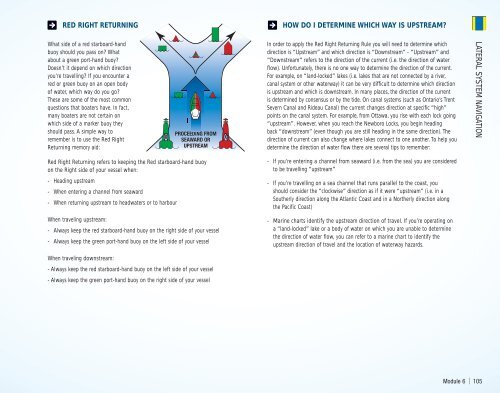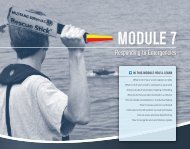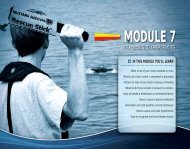MODULE 6 - BOATsmart!
MODULE 6 - BOATsmart!
MODULE 6 - BOATsmart!
Create successful ePaper yourself
Turn your PDF publications into a flip-book with our unique Google optimized e-Paper software.
RED RIGHT RETURNING HOW DO I DETERMINE WHICH WAY IS UPSTREAM?<br />
What side of a red starboard-hand<br />
buoy should you pass on? What<br />
about a green port-hand buoy?<br />
Doesn’t it depend on which direction<br />
you’re travelling? If you encounter a<br />
red or green buoy on an open body<br />
of water, which way do you go?<br />
These are some of the most common<br />
questions that boaters have. In fact,<br />
many boaters are not certain on<br />
which side of a marker buoy they<br />
should pass. A simple way to<br />
remember is to use the Red Right<br />
Returning memory aid:<br />
PROCEEDING EDINGG FROM<br />
SEAWARD OR<br />
UPSTREAM<br />
Red Right Returning refers to keeping the Red starboard-hand buoy<br />
on the Right side of your vessel when:<br />
- Heading upstream<br />
- When entering a channel from seaward<br />
- When returning upstream to headwaters or to harbour<br />
When traveling upstream:<br />
- Always keep the red starboard-hand buoy on the right side of your vessel<br />
- Always keep the green port-hand buoy on the left side of your vessel<br />
When traveling downstream:<br />
- Always keep the red starboard-hand buoy on the left side of your vessel<br />
- Always keep the green port-hand buoy on the right side of your vessel<br />
In order to apply the Red Right Returning Rule you will need to determine which<br />
direction is “Upstream” and which direction is “Downstream” - “Upstream” and<br />
“Downstream” refers to the direction of the current (i.e. the direction of water<br />
flow). Unfortunately, there is no one way to determine the direction of the current.<br />
For example, on “land-locked” lakes (i.e. lakes that are not connected by a river,<br />
canal system or other waterway) it can be very difficult to determine which direction<br />
is upstream and which is downstream. In many places, the direction of the current<br />
is determined by consensus or by the tide. On canal systems (such as Ontario’s Trent<br />
Severn Canal and Rideau Canal) the current changes direction at specific “high”<br />
points on the canal system. For example, from Ottawa, you rise with each lock going<br />
“upstream”. However, when you reach the Newboro Locks, you begin heading<br />
back “downstream” (even though you are still heading in the same direction). The<br />
direction of current can also change where lakes connect to one another. To help you<br />
determine the direction of water flow there are several tips to remember:<br />
- If you’re entering a channel from seaward (i.e. from the sea) you are considered<br />
to be travelling “upstream”<br />
- If you’re travelling on a sea channel that runs parallel to the coast, you<br />
should consider the “clockwise” direction as if it were “upstream” (i.e. in a<br />
Southerly direction along the Atlantic Coast and in a Northerly direction along<br />
the Pacific Coast)<br />
- Marine charts identify the upstream direction of travel. If you’re operating on<br />
a “land-locked” lake or a body of water on which you are unable to determine<br />
the direction of water flow, you can refer to a marine chart to identify the<br />
upstream direction of travel and the location of waterway hazards.<br />
LATERAL SYSTEM NAVIGATION<br />
Module 6 I 105








